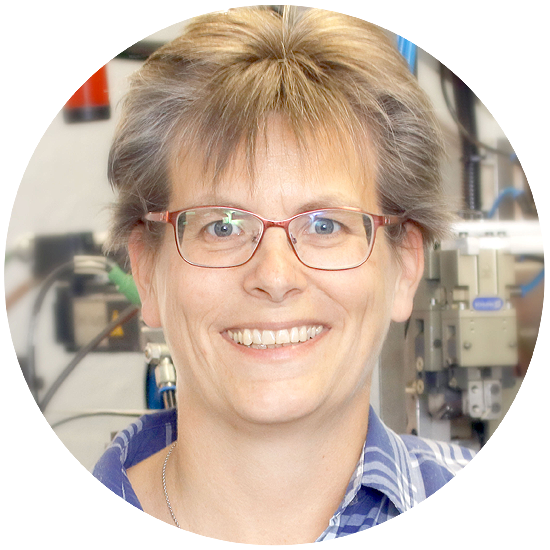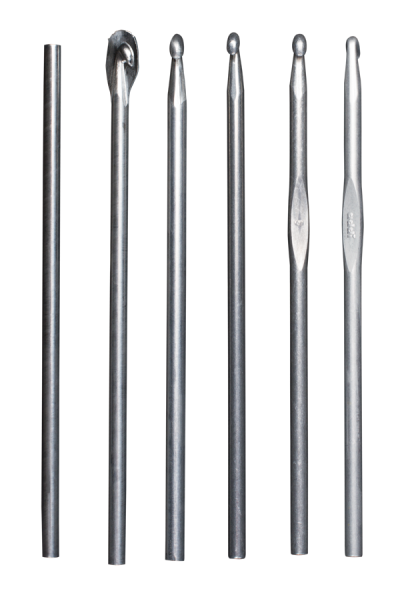Do you need a quotation or advice about our processes and services?
Our technical project manager Caroline Deutschmann, is happy to answer any of your questions.
Contact her directly at +49 (0)2352 9781 0.

EMBOSSING AND DIE-CUTTING
EMBOSSING AND CUTTING NON-FERROUS METALS AND STEEL
With the seltertech embossing and die-cutting machines, we can stamp/emboss and cut all non-ferrous metals of up to 6 mm in diameter, and steels up to 4.5 mm in the diameter, using the cold forming process. This can be done in mass production through a continuous automatic process or a manual feed. With the automatic feeding process, we are limited to a bar length of 150 mm; the manual feed can be done on up to 1000 mm length.
Processing details
Metal bars can be shaped, plated or winged by embossing them at their ends or over the entire bar.
Hooks can be stamped into different formations; the contour is then punched clean.
Swaging is possible with or without holes in various mouldings and with very tight tolerances.
Bars, to be bonded with other materials by compression or moulding, can be supplied with or without “wings” or notches in order to ensure a secure fit.
This is done using the cold forming process.
We do in-house customization of tools for embossing, die-cutting, as well as parts for feeds and jigs. We also collaborate with long-term partners.
ESSENTIALS OF EMBOSSING AND DIE-CUTTING
PROCEDURE
When embossing, a cold-forming occurs, by which the crystalline structure of the material is shifted but not separated.
In contrast to forging, the material is not tempered. The original shape of the work-piece is modified in its contour and thickness.
By shifting the crystalline structure, this sometimes create considerable hardening of the material depending on the degree of reforming.
Not all compressions are suitable for embossing. So to ensure a continuous flow of material within the embossing mould, one needs a compression, that reduces the speed of the stroke and raises the pressure. Eccentric and toggle presses are the best at meeting these requirements.
Special requirements are also placed on tools (embossing moulds) regarding the selection of materials, geometry and surface finish. During planning and construction, the tool life can be significantly affected by the choice in steel, design, and machining.
By die-cutting, we mean a process of “cutting or punching” a hole or aperture of a defined contour into the material. With punching, there is no change in the thickness of the material or its micro-structure. Die-cutting removes the excess material from the sheets or embossed parts.
Die-cutting, also has a prerequisite of selecting the right the machine, professional design and precise production of tools for durability and quality of the parts produced.
TECHNICAL PARAMETERS
Non-ferrous metals up to 6 mm in diameter
Steel up to 4.5 mm
Mass production with the automatic continuous process with bar lengths of 150 mm
Manual feeding possible with bar lengths of up to 1000 mm.
ADVANTAGES OF EMBOSSING
Processing times
The wide variety of shapes, achieved by embossing can be done alternatively on multi-axis controlled milling machines. If the milling machine requires X cycle time, the press can cast up the embossed part according to a press stroke.
Material Conservation
Processing by embossing enables material to “flow” into the tool, where the contour requires it. In machining, the largest amount of contours must always be considered; the rest are chips.
Material Loading
During cold forming, the fibre flow is not or only partially interrupted. Hardening, due to shifting of the crystalline area, is seen as an advantage for many products.
Surface Finish
The surface of an embossed part, reflects the surface condition of the tool mould. Should one have a carefully-built tool, then a surface finish of the item is generally not necessary.
GUSTAV SELTER GmbH & Co. KG
Hauptstraße 2 – 6
58762 Altena
Germany
© COPYRIGHT 2016-2023 GUSTAV SELTER GMBH & CO. KG


